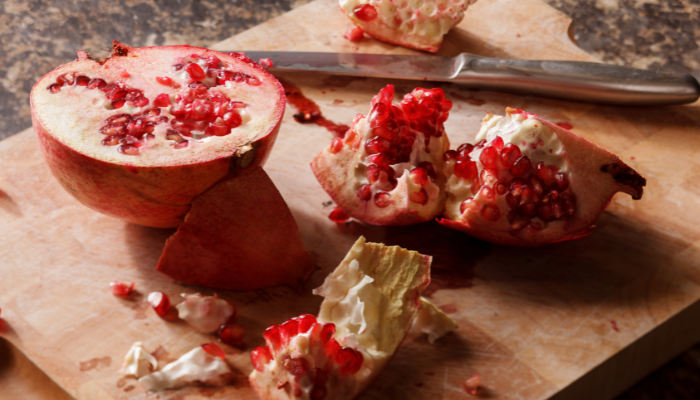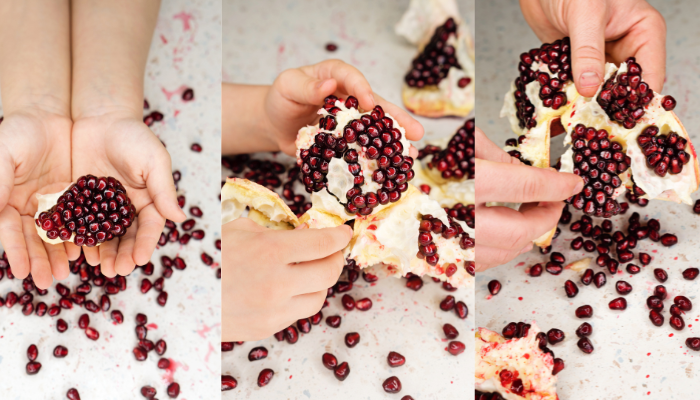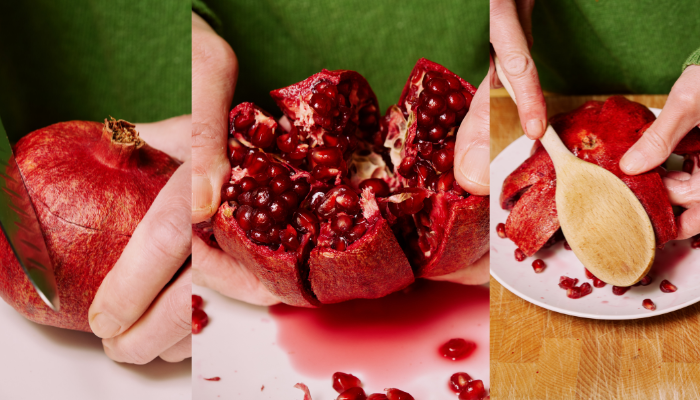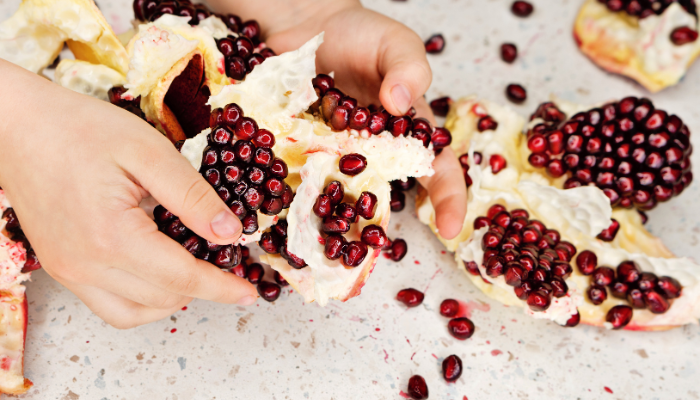Five Ways Of How to Peel Pomegranate


INTRODUCTION TO HOW TO PEEL POMEGRANATE
Pomegranates are nutrient-dense fruits that have been prized for their flavor, vibrant color, and health benefits for centuries. Originating in the Middle East, pomegranates are now grown around the world, with the peak season being from September through January.
Pomegranates have gained popularity in recent years due to the wealth of antioxidants, vitamins, and minerals they contain. Numerous studies have shown that pomegranates can help fight inflammation, lower blood pressure, and reduce oxidative stress in the body. The juice and seeds are both nutritious, making it worthwhile to properly peel a pomegranate and enjoy it.
However, peeling a pomegranate and removing the arils (seeds) can be a tricky, messy task. Many people are intimidated by trying to get to the jewel-like seeds inside. With the right technique and a bit of practice, peeling pomegranates doesn’t have to be difficult.
Cracking open a pomegranate isn’t just about revealing its juicy seeds—it’s about mastering the art of peeling it effortlessly. Delving into the method of peeling a pomegranate not only unveils its treasure trove of seeds but also promises a rewarding and delightful experience.
In this comprehensive guide, we will go over the many health benefits of pomegranates, followed by step-by-step instructions for five different methods for easily peeling pomegranates. We will also provide tips for getting the most juice out of pomegranates, how to store the seeds, and answer some frequently asked questions about peeling these fruits.
The Health Benefits of Pomegranates
Pomegranates have been eaten and used medicinally for thousands of years. Modern science is now confirming the many ways that pomegranates are good for us. Here are some of the top health benefits of pomegranates:
- Packed with Antioxidants: Pomegranates contain polyphenols, powerful antioxidants that help fight free radicals and inflammation in the body. Pomegranate juice and seeds are some of the highest antioxidant foods you can eat.
- Reduce Heart Disease Risk: Studies show pomegranates lower LDL “bad” cholesterol, improve blood flow, and decrease plaque in arteries. This may be helpful in preventing heart attacks, strokes, and atherosclerosis.
- Lower Blood Pressure: Drinking just one cup of pomegranate juice per day may lower systolic blood pressure. This is likely due to the antioxidants and ability to enhance nitric oxide production, allowing blood vessels to dilate.
- Anti-Inflammatory Effects: The antioxidants in pomegranates, especially the compound punicalagin, have been shown to combat inflammation. This can help relieve joint pain, fight chronic diseases, and more.
- Boost Immunity: Pomegranates contain vitamin C, zinc, and iron that all support a healthy immune system. The antioxidants also help strengthen resistance to illness.
- Slow Cancer Cell Growth: Certain compounds in pomegranates may help fight cancers like breast, prostate, colon, and lung cancer. While more research is needed, lab studies are promising.
- Protect Brain Health: Oxidative damage contributes to memory loss and dementia. The antioxidants in pomegranate juice appear to protect neurons and may boost memory.
- Improve Memory: Studies indicate that drinking pomegranate juice daily can improve learning, focus, and memory retention. This may be especially helpful for older adults experiencing age-related memory decline.
- Fights Bacterial and Fungal Infections: Compounds in pomegranates have antibacterial and anti-fungal properties that may be protective against infections. The peel contains especially potent antimicrobial compounds.
With all of these benefits, it’s clear that pomegranates are one of the healthiest fruits you can add to your diet. Now let’s go over the various techniques for easily peeling them.

5 Methods for How to Peel a Pomegranate
Pomegranates have a thick leathery skin enclosing hundreds of edible ruby-red arils. While peeling a pomegranate can seem intimidating, there are several easy methods to remove the rind and extract the juicy seeds inside.
Here are five of the simplest ways to peel a pomegranate with minimal mess:
The Cut Method
The cut method involves scoring the pomegranate rind into sections, submerging it in water, and then peeling away the rind. Here are the step-by-step instructions:
What You’ll Need:
- Sharp knife
- Large bowl of water
- Paper towels or dish towel
Instructions:
- Wash the pomegranate under cold running water. Dry with a paper towel or dish cloth.
- Place the pomegranate on a cutting board or other clean surface. Use a sharp knife to cut off the very top and bottom ends.
- Following the natural ridges of the fruit, make about 5-6 scores vertically around the pomegranate from top to bottom. Be sure to only cut through the skin and not into the seeds.
- Next, score the fruit horizontally into 3-4 sections from top to bottom. Again, cut only deep enough to go through the outer rind.
- Submerge the scored pomegranate into a large bowl of water for 5 minutes. This will help separate the segments of rind from the seeds.
- Remove the pomegranate from the water. Working with one section at a time, gently peel the rind away from the pomegranate. It should come off cleanly, leaving only the juicy pink-red seeds.
- Discard the pomegranate peel. Drain excess water from the seeds by spreading them out on paper towels or a dish towel. Enjoy the seeds immediately or store them for later use.
The Cut Method lets you peel a pomegranate easily under water, keeping juices contained while separating the edible portion. It does produce more peel waste but is quick and effective.

The Underwater Method
This method involves submerging the intact pomegranate in water and breaking apart the sections under the surface to contain the juices. Here’s how to do it:
What You’ll Need:
- Sharp knife
- Large bowl of water
- Paper towels or dish towel
Instructions:
- Wash the pomegranate and dry the outer skin.
- Fill a large bowl with enough water to submerge the pomegranate.
- Working with the fruit under water, score the pomegranate from top to bottom into quarters. Cut through the peel but not into the arils.
- Holding the scored fruit under the water, gently pull the sections apart with your hands. Break them into smaller segments if needed.
- While still submerged, separate the arils from the pith and peel. Discard the peel under the water.
- Remove the clean arils from the water and drain immediately on a paper towel or dish cloth. Enjoy right away or refrigerate.
Underwater peeling contains the juices for a mess-free process. It does take more time and requires working hands-on with the fruit underwater to remove the seeds. But the technique minimizes juice splatters.
The Roll Method
The roll method simply involves rolling the fruit forcefully on a hard surface to begin softening and loosening the rind. Here are the steps:
What You’ll Need:
- Cutting board or other hard surface
- Sharp knife
- Paper towels or dish towel
Instructions:
- Wash and dry the pomegranate thoroughly.
- Place the pomegranate on a cutting board or other hard, flat surface. Firmly roll it back and forth while applying pressure. Roll for 30 seconds to 1 minute.
- After rolling, use a knife to cut off the very top and bottom of the fruit so it can stand upright.
- Score the pomegranate from top to bottom into about 6 wedges, cutting through the peel but not into the arils.
- Holding the pomegranate over a bowl, gently pull apart the sections, bending them backward until they break open.
- Remove the seeds from each segment, separating them from any remaining peel or white pith.
- Drain any excess juices from the seeds. Enjoy immediately or refrigerate until needed.
Rolling the pomegranate before cutting helps soften the peel and interior membranes for easier removal. It also partially breaks apart the seed sections so they are ready to pluck out.
The Tap Method
For the tap method, you’ll firmly tap the scored pomegranate with a blunt object such as a wooden spoon to loosen and detach the seeds.
What You’ll Need:
- Ripe pomegranate
- Knife
- Wooden spoon or other blunt object
- Large bowl
- Paper towels or dish towel
Instructions:
- Wash the pomegranate and pat the skin dry.
- Use a knife to cut off the very top and bottom of the fruit so it can stand upright.
- Following the natural lines, score the pomegranate from top to bottom into about 6 wedges, cutting through the rind only.
- Holding the scored fruit firmly in one hand over a bowl, start gently tapping the rind with a spoon or other blunt object.
- Rotate the pomegranate as you tap so you are hitting each section multiple times. Continue tapping until the seeds begin falling out into the bowl below.
- After tapping, pull open the sections to release any remaining seeds stuck to the white membrane.
- Remove any stray peel from the collected seeds. Drain and blot any excess liquid.
- Transfer the seeds to an airtight container and refrigerate until ready to enjoy.
Tapping helps jostle the seeds loose so they readily fall out of the cut sections once open. Just avoid hitting too hard or the seeds can get crushed.

The Score Method
For this method, simply score the pomegranate peel into sections, pull them apart with your hands, and remove the seeds.
What You’ll Need:
- Sharp knife
- Large bowl
- Paper towels or dish towel
Instructions:
- Wash the outside of the pomegranate thoroughly. Cut off the very top and bottom.
- Following the natural ridge lines, score the pomegranate from top to bottom into about 8 wedges. Cut through the peel but not into the juicy interior.
- Over a large bowl, pull apart the cut sections with your hands, starting from the top cuts and moving down.
- Once open, use your fingers to gently pry the plump red seeds away from the white membrane and peel. Let them fall into the bowl.
- After removing most of the seeds by hand, you can use a spoon to scrape off any remaining stuck to the peel. Discard the membranes.
- Drain any excess liquid from the collected seeds. Blot with a paper towel or clean dish cloth.
- Transfer the arils to an airtight container. Refrigerate until ready to use.
The score method is quick and simple, with no special tools needed. Just rinse hands well after handling the raw fruit.
Tips for Getting the Most Juice Out of Your Pomegranate
Pomegranate seeds themselves are juicy, but you can also get extra juice by squeezing the leftover membranes after removing most of the arils. Here are some tips:
- After taking out the majority of seeds, collect any remaining arils by twisting and squeezing the peel and membranes over a bowl until no more juice comes out.
- You can also put membranes and peel in a sturdy plastic bag and press firmly with your hands to extract more juice.
- Another option is to put membranes in a sieve or colander set over a bowl and use a spoon to press against the sides, releasing the juice.
- Let membranes soak in a bowl of water for 5 minutes after removing the arils, then squeeze out the liquid which will be infused with pomegranate essence.
- Freeze membranes or whole unpeeled pomegranate for at least 2 hours, then defrost and squeeze the membranes which now release more juice due to ice crystals rupturing cell walls.
Don’t throw away the peel and membranes before getting all the available juices out. A medium pomegranate yields around 1/2 to 3/4 cup of pure juice.

Storing Pomegranate Seeds
Fresh pomegranate seeds or arils should be consumed as soon as possible, but they can keep for up to 3-5 days in the refrigerator. Here are some storage tips:
- The seeds can be kept in an airtight container or resealable plastic bag. Make sure they sit in a single layer, not piled up.
- Moisten a paper towel and place it in the container under the arils to help retain moisture.
- Squeeze a bit of lemon juice over the seeds which helps keep them from oxidizing as quickly. The vitamin C in lemons also prevents browning.
- Always refrigerate arils, preferably in the crisper drawer. Keep for 3-5 days maximum.
- If seeds start to turn brown, discard them. Otherwise, they are still usable within the 3-5 day window.
- You can also freeze pomegranate seeds for longer storage. Spread them in a single layer on a tray or pan, freeze, then promptly transfer to a freezer bag once solid. They’ll keep for 2-3 months frozen.
Storing the seeds properly ensures maximum freshness, texture, and nutritional value. Refrigerating in an airtight container with a damp paper towel is ideal.
Frequently Asked Questions About Peeling Pomegranates
Here are answers to some common questions about removing pomegranate seeds:
How do you know when a pomegranate is ripe?
Ripe pomegranates feel heavy for their size and sound hollow when tapped. They should be firm with tight skin and no soft spots or breaks in the rind. If the blossom end has turned brownish, it’s overripe.
Should pomegranates be refrigerated before peeling?
Yes, chill pomegranates in the refrigerator for 1-2 hours before peeling. The cold helps separate the membranes for easier removal.
What’s the easiest way to peel a pomegranate?
The underwater method is the easiest way for beginners. Score the rind, submerge in water, then break apart and peel under the surface to contain the mess. Or try the roll and tap methods. With practice, the score-only method gets fast and simple.
Can you peel a pomegranate directly into a bowl of water to catch the seeds?
Yes, any of the methods can be done directly over a bowl of water to catch the arils as you peel. Submerging the fruit helps contain juices for a tidier process.
How do you keep pomegranate stains off hands and clothes?
Avoid light-colored clothing when prepping pomegranates. Wear an apron if needed. Rub hands with lemon juice immediately after peeling to help remove stains. Wash clothes in cold water to prevent setting in the red pigments.
Can you eat the white pomegranate membrane?
The juicy red seeds are edible, but the white pithy membrane is bitter and unpleasant. Always separate the arils from the white pith before eating or juicing. The peel is also inedible.
Do pomegranates need to be organic?
Pomegranates tend to have thick skin that protects the seeds, so buying non-organic is okay. But organic is ideal if you want to avoid pesticides completely. Always wash the fruit before peeling even if organic.
Conclusion Of How to peel pomegranate
When armed with the proper technique, peeling pomegranates doesn’t need to be an intimidating kitchen task. With a variety of efficient methods to choose from, you can remove the sweet ruby-red arils cleanly and simply. Taking the time to properly peel pomegranates allows you to enjoy their delightful seeds and juice and get the most from these nutrition-packed fruits.




